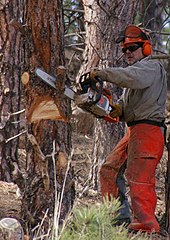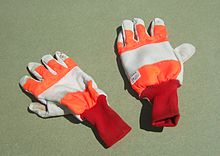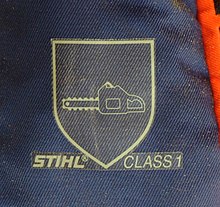Chainsaw safety clothing

Safety practices generally recommend that chainsaw users wear protective clothing, also known as personal protective equipment or PPE, while operating chainsaws.[1][2] There is general agreement worldwide on what clothing is suitable, but local jurisdictions have specific rules and recommendations.
Clothing

Helmet
The helmet attempts to protect the user's head against impact with the cutter bar of the chainsaw should a kickback occur. Protection can only be successful if the chain brake has operated to stop the cutter chain as a chain running at full speed can easily cut the helmet. A helmet also protects against impacts from small falling objects, such as a dead branch from a tree being felled.[3]
Exposure to the sun will cause the plastic of the helmet to weaken over time so it is recommended that the helmet is replaced every 3–5 years. Helmets commonly have a symbol inside that shows when it was made. Many helmets also now have a sticker on the outside that fades with exposure to light, so when faded it should be replaced. To determine if a helmet shall be changed is to press the side of the helmet. When cracking noise is heard, the helmet is subject to change.
In the EU, the helmet should meet the requirements of EN397.[1] Helmets as well as other safety equipment in Germany shall have the KWF sign.
Visor or goggles
A visor or goggles reduce the chance of chips penetrating the user's eyes.
The relatively flimsy mesh visor, with imperfect coverage of the face, is considered acceptable because the chips produced by well-maintained chainsaws are of relatively uniform size and speed. Unlike other woodworking tools, a chainsaw with a sharp chain produces little or no sawdust, only chips (that are too large to fit through the visor's mesh).
Some chainsaw users prefer conventional safety glasses or goggles.[2] The choice may depend on the environment. The visor provides better ventilation for hard work in hot weather. Often, both safety goggles and a visor are employed for superior protection.
In the EU, a visor must comply with EN1731, or glasses must comply with EN166.[1]
Chainsaw safety mitt
A leather mitt for the operator's left hand that is fitted to (but is free to rotate on) the front bar of the chainsaw.
The safety mitt ensures that if kickback occurs the operator's hand remains on the bar of the chainsaw. This means that the kickback is more easily controlled and the chain brake is engaged. The safety mitt also protects the operator's left hand in the same way as chainsaw safety gloves. The protection on the left hand mitt protects when the chain re-reils and jumps over the the front handle.
Most safty mitts have a protection class 0 (up to 16 m/s chain speed, see below). There are mitts available covering class 1 (20 m/s chain speed.
Ear defenders
Ear defenders and ear plugs attenuate noise to levels that cause little or no damage to the user's hearing.[2][3] Non-electric chainsaws are very loud, typically 115 dB, above the recommended exposure limit of 85 dB from the National Institute for Occupational Safety and Health.[4]
In the EU, ear defenders must comply with EN352-1.[1]
Trousers
Special fabrics have been developed for chainsaw clothing, and this development is still very active. Conventional fabric is useless at protecting against a running chainsaw, being immediately cut through.
There is a real struggle between making a fabric proof against more violent impact, and making it light, flexible and comfortable enough for the user. Clothes which make the user too hot, or which prevent the user moving easily, are a safety problem in themselves. A worker suffering from heat exhaustion is not safe. Extra fabric layers can be added to clothing to improve cut resistance, but clothes which cannot be cut at all by a powerful saw are impractical, even with modern fibres. What is worse, saw and chain technology seems to be outstripping fabric technology. High power saws with aggressively cutting chains are almost impossible to protect against.
A classification scheme has been developed in the EU to rate trousers, and fabric in general, for protection against cutting.
| Class | Max chain speed |
|---|---|
| 0 | 16 metres per second (36 mph) (3150 feet per minute) |
| 1 | 20 metres per second (45 mph) (3937 feet per minute) |
| 2 | 24 metres per second (54 mph) (4724 feet per minute) |
| 3 | 28 metres per second (63 mph) (5512 feet per minute) |
The chain speed is specified in the manual for a chainsaw. Higher class trousers are more expensive, hotter, and heavier, so there is an advantage to choosing the trousers to match the saw.
There are two standard types of trousers, type A and type C. Type A protects only the front of the legs, and can be supplied as chaps, worn over conventional work clothes, or as conventional trousers. Type C gives protection all round the legs and are almost always worn as ordinary trousers, not over another garment. Chaps are generally used for occasional, farm or homeowner applications.[5] Professional chainsaw operators would choose trousers for comfort and ease of movement, with fallers, ground workers and firewood cutters opting for class A trousers because of the low risk of being cut in the back of the leg. Climbers and tree surgeons would have to wear type C, as they will be cutting from a wider variety of positions. Type C trousers are, of course, highly insulating, and may lead to heat stress if worn for labour-intensive operations such as firewood cutting. Chainsaw protective fabric works on a number of principles. The outermost layer can be made both tough and slippery, to protect against trivial damage which could compromise the filler material. Beneath this, long, loose fibres of polyester, ballistic nylon or Kevlar are laid in layers. When a saw contacts the trousers, the outer layer is immediately cut through but the inner is drawn out and wraps around the saw's drive sprocket, locking it solid and halting the chain, limiting damage to the operator's leg. The length of the fabrics and number of layers matched the safety class. In case of an accident the fabric is pulled out of the upper and lower seam and wrapping into the sprocket as desribed above. Protection is only given for gas chain saws not on electrical saws. Trousers should be slightly baggy, so that there is give and not the chain pulling the leg into the chainsaw, but instead pulling excess stopping fabric into the chain mechanism. After stopping a saw, the trousers are scrapped, and the saw must be field-stripped to remove the fibres and allow it to run again.
If trousers are washed the material inside may degrade over time. As a result, trousers should be replaced, and not washed in hot water too frequently. Likewise trousers should be free of rips and tears that may catch on a chain saw or timber when moving through a forest.
In case the trouser is damaged it is allowed to repair it as long the protective fabric on the inside is not damaged. If it is damaged the trouser is no longer safe.
Chainsaw protective trousers in the EU must comply with EN381-5.[1]
Jacket
Chainsaw protective jackets in the EU must comply with EN381-11.[1]
For detailed information on fabric ratings, see the section above on trousers. The logic is much the same - the protective materials are designed to slow the chain's rate of cutting and clog the mechanism, rather than protect the wearer completely.
Gloves

Chainsaw gloves have cut-proof fabric protection like that for trousers, but only on the back of the left hand. It's especially important that work gloves are flexible, which limits how much padding they can have. Experience has shown that most chainsaw injuries to the hands occur on the back of the left hand.
In the EU, chainsaw gloves must comply with EN381-7.[1][2]
Boots
Chainsaw boots are based on ordinary steel-toe boots, but have layers of chainsaw protective fabric on the exposed front surfaces. They are available in lace-up leather or rubber wellington boot versions. Popular manufacturers of chainsaw boots sold in Europe include Haix, Klima-Air, Rock Fall, Meindl and Oregon.
Boots protect the operator from front and ceratin extend from sideways cuts.
In the EU, chainsaw boots must comply with EN345-2.[6] These boots must be to the appropriate EN20345 standard for general safety footwear[2] and must also be distinctively marked as suitable for chainsaw use, according to EN381-3[1]
Protective chainsaw gaiters to EN381-9 over general steel-toe boots are acceptable for occasional users.[1]
Chainsaw logo

In the EU, chainsaw trousers, boots and gloves (the items containing chainsaw protective fabric) must carry a special chainsaw logo.[2] This shows that the fabric is of a type tested to protect properly, and also shows the class of protection, the rated maximum chain speed.
Additional personal protective equipment (PPE)
First aid kit
In the UK and Germany, workers are required to carry a first aid kit containing at least a large wound dressing.[2][7]
Whistle and cell phone
In the UK, workers are recommended to carry a whistle to call for help if they are injured. Colleagues may be close by, but unable to hear over the noise of chainsaw(s) still running. The whistle tends to overcome this.[8]
In Germany there is an App for Android phones "Hilfe im Wald" ("Help in the forest") available. This app shows the next secutity point where ambulances have access. These safety points are numbered and visible by a pole with orange head and the number on. These numbers are known to ambulances.
See also
References
- ^ a b c d e f g h i "Chainsaws at work" (PDF). HSE. 2006. p. 5.
- ^ a b c d e f g Arboriculture and Forestry Advisory Group. "Using petrol driven chainsaws" (PDF). HSE. AFAG 301.
- ^ a b "Chain Saw Safety Manual" (PDF). Stihl. 1999. p. 6.
- ^ CDC - Noise and Hearing Loss Prevention - Noise Meter Flash. The National Institute for Occupational Safety and Health.
- ^ Type A or Type C chainsaw trousers?
- ^ Barnes, Sam. "Chainsaws at work" (PDF). HSE.gov.uk. HSE.
- ^ HSE, Chainsaws at work, p. 6
- ^ HSE, Chainsaws at work, p. 6

